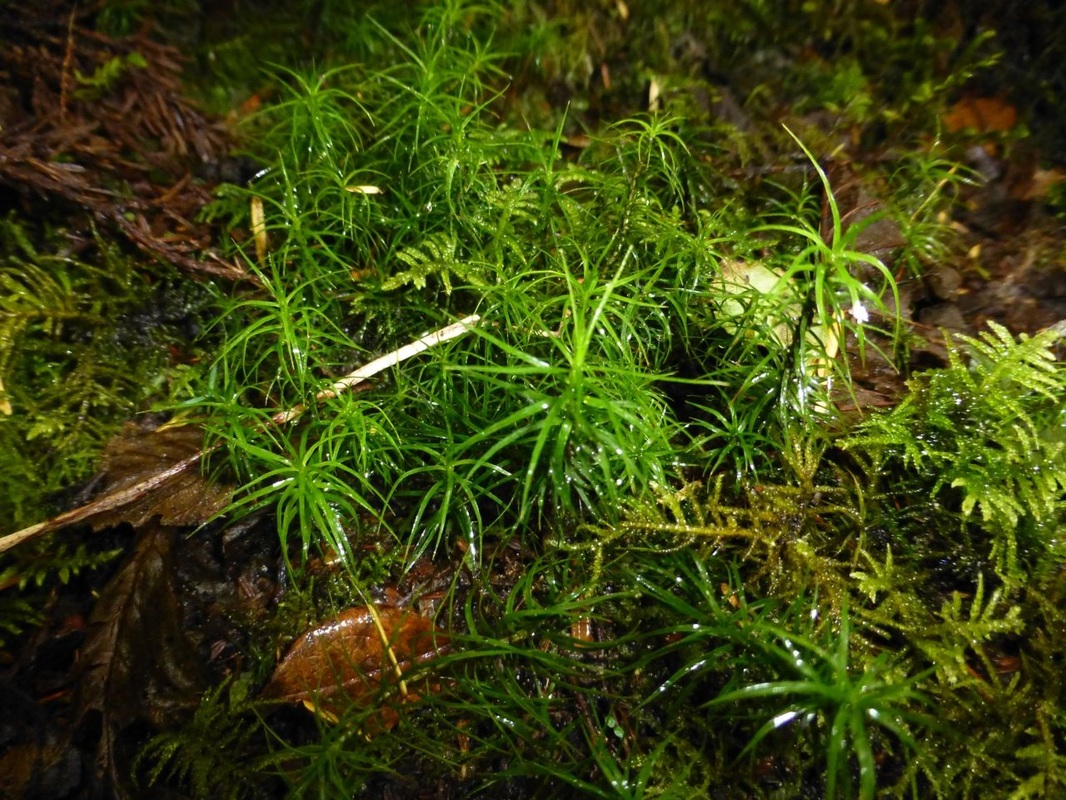Alpine haircap moss • Polytrichastrum alpinum
Identification
Alpine haircap moss is a medium-sized (4-10 cm tall) upright to prostrate moss species. It may be unbranched or loosely branched. It has dark green linear- to lance-shaped leaves with wide bases that sheath the stem. The leaves are reduced near the base of the stem - a distinguishing feature of this species. Sporophytes are borne near the tips of the stems, and are green when young then turn brown. Click here for more detailed identification information.
Habitat & Range
Alpine haircap moss forms loose turfs on soil and rotting wood; common habitats include rotting logs, roots of overturned trees, coniferous forest floors, and in cliff crevices. Its known range in North America extends from Alaska to California; it is also recorded in other locations around the world, including the United Kingdom.
Similar Species
Polytrichum species, such as juniper haircap moss (P. juniperinum) and common haircap moss (P. commune), may appear similar initially but should be distinguishable upon closer examination. They are also found in different habitats.
Alpine haircap moss is a medium-sized (4-10 cm tall) upright to prostrate moss species. It may be unbranched or loosely branched. It has dark green linear- to lance-shaped leaves with wide bases that sheath the stem. The leaves are reduced near the base of the stem - a distinguishing feature of this species. Sporophytes are borne near the tips of the stems, and are green when young then turn brown. Click here for more detailed identification information.
Habitat & Range
Alpine haircap moss forms loose turfs on soil and rotting wood; common habitats include rotting logs, roots of overturned trees, coniferous forest floors, and in cliff crevices. Its known range in North America extends from Alaska to California; it is also recorded in other locations around the world, including the United Kingdom.
Similar Species
Polytrichum species, such as juniper haircap moss (P. juniperinum) and common haircap moss (P. commune), may appear similar initially but should be distinguishable upon closer examination. They are also found in different habitats.
References
Ellis, S. Polytrichastrum alpinum (Hedw.) G.L. Smith. Introduction to Bryophytes. Biology 321, Department of Biology, University of British Columbia, Vancouver. Accessed 29/08/2014.
Polytrichastrum alpinum (Hedwig) G. L. Smith [Polytrichaceae]. California Moss eFlora. University Herbarium, University of California, Berekely. Accessed 29/08/2014.
Rumsey, F. Polytrichastrum alpinum. British Bryological Society. Accessed 29/08/2014.
Authors and editors of page
Kelly Fretwell, Ian Cruickshank, and Brian Starzomski (2014).
Ellis, S. Polytrichastrum alpinum (Hedw.) G.L. Smith. Introduction to Bryophytes. Biology 321, Department of Biology, University of British Columbia, Vancouver. Accessed 29/08/2014.
Polytrichastrum alpinum (Hedwig) G. L. Smith [Polytrichaceae]. California Moss eFlora. University Herbarium, University of California, Berekely. Accessed 29/08/2014.
Rumsey, F. Polytrichastrum alpinum. British Bryological Society. Accessed 29/08/2014.
Authors and editors of page
Kelly Fretwell, Ian Cruickshank, and Brian Starzomski (2014).




